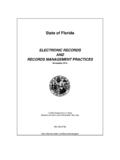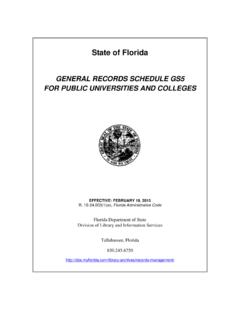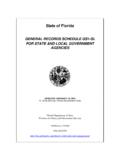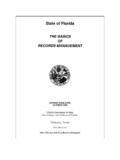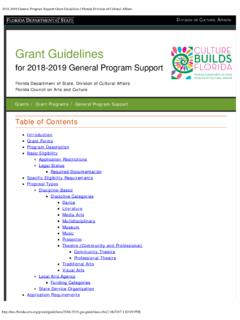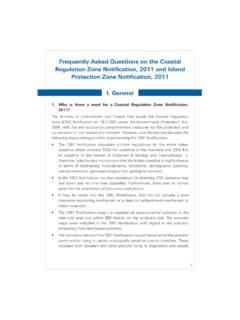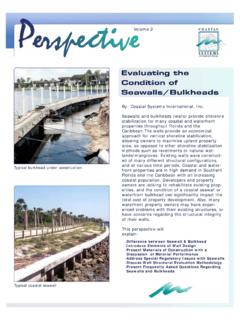Transcription of The Florida Greenbook: Environmental and Historic ...
1 Florida Division of Emergency Management FDEM THE Florida greenbook : Environmental AND Historic preservation compliance The Florida greenbook : Environmental and Historic preservation compliance Florida Division of Emergency Management 2555 Shumard Oak Boulevard Tallahassee, Florida 32399-2100 Contributing Authors: Henry Hernandez Ginger Shirah Rick Knowles Adele Balmer All photographs courtesy of Department of Homeland Security, Federal Emergency Management Agency August 19, 2015 Table of Contents Introduction .. 1 Federal Environmental Laws .. 2 National Environmental Policy Act .. 2 Clean Water Act .. 3 Endangered Species Act .. 3 Fish and Wildlife Coordination Act.
2 3 Clean Air Act .. 3 Executive Order 11988: Floodplain Management .. 4 Executive Order 11990: Wetland Protection .. 4 Farmland Protection Policy Act .. 4 Coastal Barrier Resources Act .. 4 Coastal Zone Management Act .. 5 Wild and Scenic Rivers Act .. 5 National Historic preservation Act .. 5 Executive Order 13175: Consultation and Coordination with Indian Tribal Governments .. 5 Executive Order 12988: Environmental Justice .. 6 Migratory Bird Treaty 6 Magnuson-Stevens Fishery Conservation and Management Act .. 6 Environmental Review Roles and Responsibilities .. 7 General Environmental Guidance for Applicants .. 8 Special Environmental Review Requirements for Hazard Mitigation Assistance.
3 9 Environmental Review Requirements by Project Type .. 10 10 Roads and Bridges .. 10 Debris .. 10 Vector Control .. 11 Acquisitions and Retrofits .. 11 Drainage Improvements .. 11 1 Table of Contents SPECIAL CONSIDERATIONS - "Nine Questions" .. 13 EHP Comments .. 19 Project Closeout .. 19 Permits, Conditions and Documentation .. 19 Permits .. 20 Permit Conditions .. 25 Documentation .. 25 USFWS Biological Opinions .. 28 Historic preservation .. 29 Public Assistance and Mitigation Program Resources .. 31 Agency Contact Information .. Appendix A Beaches Quick Guide .. Appendix B Roads and Bridges Quick Guide .. Appendix C Debris Quick Guide .. Appendix D Vector Control Quick Guide.
4 Appendix E Acquisitions and Retrofits Quick Guide .. Appendix F Drainage Improvements Quick Appendix G Sample of Public Notice .. Appendix H Frequently Asked Questions .. Appendix I Glossary .. Appendix J 2 INTRODUCTION It is the goal of the National Environmental Policy Act (NEPA), which includes the Environmental and Historic preservation review process, to ensure the environment is considered before any federal action or funding is implemented. At the Florida Division of Emergency Management (FDEM) it is important that as we prepare for, recover from, and mitigate against disasters, NEPA compliance requirements are met. The Federal Emergency Management Agency (FEMA) and the State of Florida jointly fund eligible, cost-effective, and environmentally, culturally, and historically sound projects.
5 The review process evaluates FEMA funded projects for compliance with federal, state and local laws designed to protect citizens, the environment, and cultural and Historic resources. The Florida greenbook : Environmental and Historic preservation compliance was prepared to provide an overview of the Environmental review process. The objectives of this guide are as follows: Provide a review of federal Environmental laws and executive orders. Provide a review of Historic preservation laws and executive orders. Define the roles and responsibilities of the applicant, State, and FEMA. Outline the Environmental review process by project type. All FDEM projects that receive any federal funding are subject to review for Environmental and Historic preservation compliance .
6 NEPA mandates that any project using federal funding is legally required to undergo Environmental review. Failure to complete the proper Environmental review could result in delays or jeopardize federal funding. If the project is implemented before NEPA review has been completed, funding may be denied. No funds for project costs will be released until the Environmental review is complete and the project has been obligated by FEMA. Ghost Orchid (Dendrophylax lindenii) Endangered species - native to the Everglades and other South Florida wetlands 1 FEDERAL Environmental LAWS The following section will provide an overview of the federal Environmental laws which may apply to projects seeking federal reimbursement.
7 NEPA applies to all federal projects. Other laws may apply to specific project types, locations, and potential resources. These laws are generally addressed during the NEPA review process. Appendix A contains contact information for all review/regulatory agencies. In addition to the NEPA review process the project must meet all applicable federal, state and local Environmental laws and regulations. National Environmental Policy Act NEPA was established to create a cohesive national Environmental policy and to provide federal agencies with a decision-making process to protect and maintain the environment.
8 NEPA stipulates that prior to funding or implementing an action, federal agencies must consider the effect the proposed undertaking may have on the environment. Under this legislation, agencies are required to address each project on a larger scale, taking into account all consequences as well as the effect of accumulated impacts on the environment. Through NEPA s mandate for public disclosure, the public must be given an opportunity to participate in the decision-making process. NEPA requires not only that the proposed action be evaluated, but that several alternatives are evaluated, including a no action alternative. A review of an action under the NEPA process has several possible outcomes: Statutory Exclusion (STATEX) An action may be exempt from review under NEPA.
9 Only Congress can statutorily exclude an action. For a complete list of excluded actions, please see 44 CFR (c). Generally these are emergency actions ( , life and safety issues, search and rescue), debris removal, and repair or restoration to pre-disaster condition. However, exemption from further NEPA review does not preclude compliance with all other laws. Categorical Exclusion (CATEX) A categorical exclusion is a list of actions that FEMA has determined to have no significant impact on the environment. Currently FEMA has 19 categories of actions which include such things as studies, acquisitions, elevations, retrofits, and small-scale construction.
10 Please see 44 CFR (d)(2) for details. Environmental Assessment (EA)/FONSI/NOI-EIS An EA is a brief and concise review to determine if an action (project) will have a significant effect on the environment. The project applicant prepares the EA, which is then submitted to FEMA for evaluation. FEMA can either grant a Finding of No Significant Impact (FONSI), thus concluding the Environmental review process, or a Notice of Intent to prepare an Environmental Impact Statement (EIS). Environmental Impact Statement (EIS) An EIS is a much more extensive review of impacts analyzing and documenting the impact the action will have on the environment.

